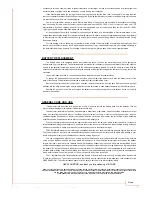
Product
Detectors
Coils
Accessories
Catalog
Dealers
Information
Frequently Asked
Questions
About Tesoro
Manuals
Field Tests
Articles
Testimonials
Customer Finds
Forums
Service
Warranty Repair
Contact Us
Deep Search VI OPERATOR INSTRUCTION MANUAL
GENERAL DESCRIPTION
The Deep Search VI is a Transmitterreceiver (TR) Metal Detector, operating in the very low frequency (VLF) portion of the
RF spectrum. The detector utilizes the natural phenomena of the phase delay of all targets to provide mineralfree or ground
compensated response in the normal mode of operation, or to provide discriminate capability in the discriminate mode.
The design of the Deep Search VI was implemented not only to provide excellent sensitivity, but to provide a unit which is
easy to use for both the beginner and the expert treasure hunter.
As with any detector, the familiarity of the user with the instrument will have a great deal to do with how successful the
treasure hunter is. We recommend that you read and understand this manual fully before attempting to use the instrument in
the field.
Be sure to fill out and mail your warranty registration card to validate your warranty.
ASSEMBLY
Assembly of the Deep Search VI is very simple, and requires no special tools. The only assembly required is to mount
the searchcoil to the end of the lower stem and install the lower stem and lock nut assembly to the upper stem.
1.
Insert the pole tip between the mounting ears of the searchcoil, after removing the screw and thumb nut. Align the
holes in the pole tip and those in the mounting ears.
2.
Insert the coil mounting screw through the coil and pole tip. Be sure the internal tooth lockwasher is on the screw
head side. The screw head should be on the side of the searchcoil where the cable comes out.
3.
Install the thumb nut on the screw and tighten by hand.
4.
The knurled locknut is installed on the upper stem to protect the threads during handling and shipment. Remove the
locknut and slide it onto the lower stem as shown. Be sure the lock ring is inside the locknut or behind it, so that it will
be pushed into the locknut when the locknut is reinstalled on the threads.
5.
Insert the lower stem into the upper stem, push the locknut up to engage the threads, and tighten it finger tight.
6.
Wind the searchcoil cable around the pole, and install the searchcoil connector into the connector on the front of the
chassis. Tighten the connector finger tight.
ADJUSTMENT
The searchcoil angle and stem length should be adjusted so that the unit is not uncomfortable or tiring after long periods
of use. The stem length is adjusted by loosening the knurled locknut and extending or collapsing the stem length until the unit
can be held about an inch off the ground while standing erect. Adjust the angle of the searchcoil, so that the coil is parallel to
the ground. Tighten the searchcoil thumbnut and stem locknut by hand to maintain this setting.
CONTROLS
The function of the front panel controls of the Deep Search VI are as follows, beginning in the lower left hand corner, and
proceeding in a clockwise direction.
1.
Mode Switch.
This switch is a three position toggle switch which selects the basic detector operation mode.
A.
Battery Test.
This position is used to check the condition of the batteries. The battery test should be performed after the detector has
been on for about 10 minutes, and with a moderate to heavy amount of sound. A meter reading of .6 or above indicates the battery strength
is adequate for proper operation. If the meter reading is below .6, replace the batteries.
B.
Norm.
This position selects Normal or All Metal mode. In the Normal position, the detector can be adjusted to ignore ground
mineralization for maximum depth, but the detector will not discriminate against unwanted metals such as iron, bottle caps, etc.
C.
Disc.
This position selects the Discriminate mode of operation, whereby response to unwanted metal objects such as iron, bottle caps,
thin foil pieces, etc., can be controlled. Ground mineralization will affect the operation of the detector in this mode.
2.
Disc Level.
This control is used to adjust the detector's response to unwanted metallic trash when used in the
Discriminate mode. At the lowest setting, "0", the detector will eliminate most iron objects, but will still respond in a
positive manner to light foil, bottle caps, pull tabs and other most other metallic items. As the knob setting is increased,
response to more of these metallic trash items is reversed, so that these objects give a negative or "nulling" response.
3.
Tuning.
This control is used to tune the detector to its most sensitive setting, regardless of which mode is used.
Since the target response of a TR detector is an increase in sound level, the ideal setting for maximum depth is so that
the detector is just beginning to make sound. This "threshold" setting should be maintained at all times, as operating the
detector completely silent means a deep target may have insufficient response to drive the detector out of the quiet region
and into "threshold".
4.
Sensitivity.
This control adjusts the detector's sensitivity to ground effects due to mineralization, as well as its
sensitivity to metallic targets. In the normal mode of operation, the detector will ignore effects of mineralization if it is
properly adjusted, so the detector can be operated in maximum sensitivity in almost any ground in the mode. In the
discriminate mode, the ground effects are not ignored, so the detector may perform better in heavily mineralized ground at
reduced sensitivity.
5.
Ground Adjust.
This control is used to adjust the detector so that it does not respond to the mineralization in the
ground, when used in normal mode.
6.
ON/OFF Volume.
This control adjusts the amplitude of the audio signal, as well as controlling the power to the unit.
When using the internal speaker, the volume control should be at its maximum clockwise setting for maximum depth.
When using headphones, the internal speaker is disconnected, and the volume control should be set for maximum
comfortable volume.
7.
Tuning Push Button Switch.
This switch is located in the end of the hand grip where it is easily depressed with the
thumb. This switch is used to reset the detector tuning to the desired threshold anytime conditions cause a tuning
change in the detector.
TUNING
A.
Normal Mode Tuning.
1.
Turn ON/OFF Volume control fully clockwise.
2.
Turn the Ground Adjust control to about 6. Set the sensitivity control to mid range (pointer straight up).
3.
Hold the Tuning push button switch in.
4.
Turn Tuning control as required to get a moderate audio sound and a meter reading of about .4.
5.
Hold the coil about 2 feet above the ground, and release the push button.
6.
Lower the searchcoil to within an inch of the ground, and observe meter reading change and audio change as the coil is lowered.
7.
If the meter reading and the sound increase, turn the Ground Adjust control down slightly (counterclockwise). If the meter reading and
the sound decrease, turn the Ground Adjust control up slightly (clockwise).
8.
Raise the coil back to about two feet above the ground, and momentarily depress the TUNING switch to re establish the tuning threshold.
9.
Repeat steps 6, 7, & 8 as required, until there is almost no change in the meter reading and the sound as the coil is lowered to the
ground.
NOTE:
The ground must be free of all metallic items where the coil is lowered. If the Ground Adjust control is turned completely
counterclockwise and the detector still give an increase as the coil is lowered, a target is under the coil. Move to another spot and repeat the
tuning procedure.
10.
Push the Tuning push button, and turn the Tuning control down to get just a faint audio buzz.
The detector is now ready to use in the Normal mode of operation. Once the detector is Ground Compensated, remember the number setting
on the Ground adjust control, and use it as a starting point next time.
B.
Discriminate Tuning.
1.
The Deep Search VI will give best operation in the Discriminate Mode if the Ground Adjust control is properly adjusted as outlined in
the Normal Mode Tuning, so perform this procedure first.
2.
Put the Mode Switch in the DISC position. Adjust the Disc Level control to provide the desired level of discrimination.
3.
Hold the searchcoil about 1 to 2 inches above the ground. Momentarily depress the Tuning pushbutton switch to establish the tuning
threshold.
4.
Raise and lower the searchcoil slightly, and note the tuning changes. If a slight upward movement causes a full scale meter deflection
and maximum audio, the ground is heavily mineralized, and may require a lower sensitivity setting. If the detector can tolerate an upward
movement of several inches before pegging the meter and audio, the ground is lightly mineralized and the Sensitivity knob can probably be
adjusted higher.
5.
Adjust the Sensitivity control to the highest setting that will allow you to sweep the detector from side to side and still maintain the
threshold. Attempting to operate the detector in Discriminate Mode at maximum sensitivity in heavily mineralized ground will almost always
result in a loss of performance.
FIELD USE
The detector should be held in a position that is comfortable for you. Swing the detector from side to side in about a three
foot arc. The Deep Search VI does not need to be hurried, so go at a pace that doesn't wear you out.
Keep the detector tuned so that it is just beginning to buzz. In Normal Mode the detector ignores the ground, if properly
adjusted, so this is easy to do. In Discriminate, the ground will affect the detector, so you should sweep the detector at a
constant height above the ground (about 1 inch). Irregularities in the ground, as well as in your sweep height will cause
variations in the tuning. These changes will usually be much slower than the abrupt signal caused by the coil passing over a
good target. A little practice with a coin buried about 1 inch will enable you to pick out the target sound readily, as compared
to the background variations. Turning the Sensitivity down will make it easier to maintain threshold. Always operate in
Discriminate with the Sensitivity control set only as high as will allow you to operate in the unit at threshold.
In areas with well kept lawns, the easiest way to maintain a constant searchcoil height is to allow the coil to rest on the
grass as you sweep from side to side. In rough and rocky areas it is best not to “scrub” the coil on the ground, as the rocks
will act like abrasives, and wear away the coil bottom.
To pinpoint or locate a target which doesn't peg the meter and audio, simply move the coil around to find the point where
the loudest audio and highest meter reading is given. The target will be right below the center of the coil. If the target response
is so strong it pegs the meter and audio, simply push the tuning button momentarily over the strongest signal. This will tune
out most of the response to the target and the detector will go totally quiet if it is moved away from the target. It may be
necessary to retune a couple of times to almost totally tune out the target, but you will eventually arrive at a tuning level that
will not saturate or peg the meter and audio when you are directly over the target.
In the Discriminate Mode, the tuning will have to be reset any time that the Disc Level is changed. This merely requires
that you momentarily depress the pushbutton tuning switch. By being familiar with your detector and where typical junk items
are rejected can save you much needless digging.
One thing to remember, though, is that in Discriminate Mode, it is best not to use any higher Discriminate Level setting
than necessary. Nickels and most small rings are rejected when the DISC LEVEL is set to reject pull tabs on all TR
Discriminators. If you don't dig any junk at all, you are surely passing up a lot of other good finds too. Set the DISC LEVEL
only high enough to suit the conditions where you are searching.
At lower settings of sensitivity, the detector can usually be switched from Normal Mode to Discriminate Mode or vice
versa without affecting the tuning. At maximum sensitivity some small effect may be encountered when switching from Normal
to Discriminate, so if the threshold sound does go away or gets too loud when switching Modes, simply depress the Tuning
Button momentarily.
For relic hunting or for coinshooting in areas that are free of trash, the Normal Mode of operation will normally give best
results, since the detector is easy to use with maximum sensitivity. It may be desirable to operate with reduced sensitivity in
the Normal Mode at times, however. For example, to prevent having to dig large, deep holes in a well kept park lawn.
BATTERY REPLACEMENT
The Deep Search VI is equipped with an internal battery check circuit so you can always know you're getting top
performance from your detector. The batteries should be tested after the detector has been operated for about ten minutes,
and while the detector is making a loud noise, so the batteries are properly loaded. To force the audio on, simply hold the
searchcoil near a large metal object while checking the batteries, or depress the tuning button and turn the Tuning control fully
clockwise.
If the meter reads less than .6, the batteries should be replaced to ensure best performance.
To change the batteries, depress the chrome buttons on each side of the detector, and slide the battery cover off the
back of the chassis. The batteries are contained in a plastic holder just behind the cover.
Remove the battery pack from the detector, and then remove the batteries from the pack. Replace the new penlight
batteries into the pack, observing the polarity indicators that are embossed in each battery compartment of the battery pack.
Replace the pack into the holder, and replace the battery cover by depressing the chrome buttons as the cover is slid
back into the chassis.
GENERAL CARE AND USE
If the detector is to be stored for a long period of time, it is best to remove the battery pack from the detector. This will
prevent internal damage to the detector if the batteries should leak.
The searchcoil is waterproof and may be submerged in either fresh or salt water. Caution should be exercised to prevent
water from entering the chassis, where it could damage the electronic circuitry, or from entering the upper stem, where it
could damage the push button or leak into the chassis. After the coil is used in salt water, the coil and lower stem assembly
should be rinsed well with fresh water to prevent corrosion of the metal parts.
There are several good books to help the beginner learn how to use the detector, where to search and how to recover a
target without damaging the environment. A good coin shooter can recover a lot of finds and leave the area looking as though
he had never been there. Above all, always fill your holes when you have recovered the target.
TESORO Metal Detectors are sold through independent dealers, who are almost always treasure hunters themselves.
They can provide you with you much needed information about how to use your detector, how to probe, plug and dig in your
locale, and answer most of your questions about treasure hunting in general.
The use of earphones will benefit you in two ways. Most earphones will very effectively block out most of the ambient
noise, such as traffic noise and wind noise, which will enable you to better hear the fainter signals caused by the deeper
targets. Obviously, the older, more valuable coins will probably be deeper than the ones which were lost last week, so you
should take advantage of anything that will help you hear the weaker signals. Secondly, using earphones will greatly extend
the battery life, since it takes much less power to operate them. The Deep Search VI is not equipped with a volume control,
but does have a limiting circuit in the earphone jack. If less volume is desired with earphones, you may want to use earphones
with a built in volume control. Any good 8 or 16 ohm set with 1/4 inch stereo jack will do.
The 7" coplanar searchcoil furnished with the Deep Search VI is optimized for coin hunting, but will work as well as most
8" coils for relic hunting. The serious relic hunter will probably want to consider the larger wide scan coils available for the
DEEP SEARCH VI. They offer increased depth for relics, but at a sacrifice in the discrimination ability.
HAPPY HUNTING, and thank you for purchasing a TESORO.
Under the copyright laws this documentation may not be copied, photocopied, reproduced, translated or reduced to any electronic or
machine readable form, in whole or in part, without the prior written consent of Tesoro Electronics Incorporated, except for the private
use of a Deep Search VI owner or operator, or in a manner otherwise described in this documentation.
© 19951996 Tesoro Electronics Incorporated. All rights reserved. Printed in the United States.
Tesoro Electronics, Inc. 715 White Spar Road Prescott, AZ, USA 86303 1928 771 2646






















